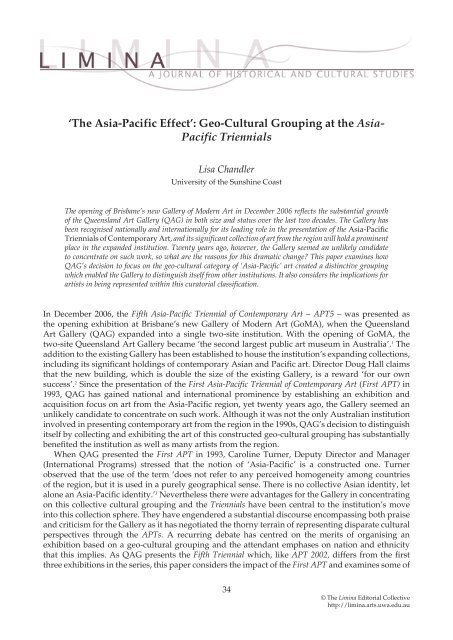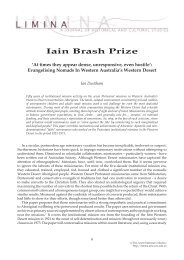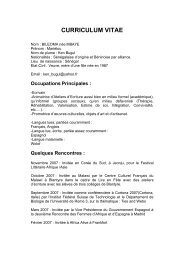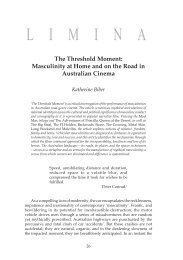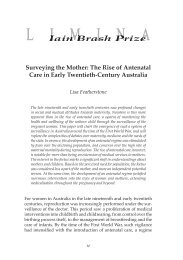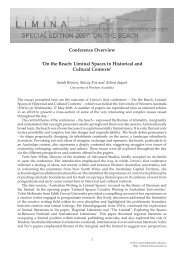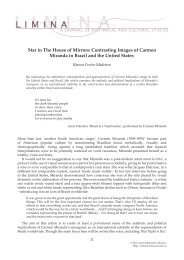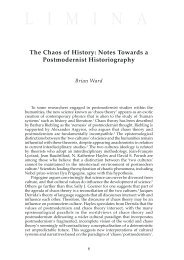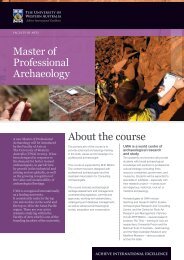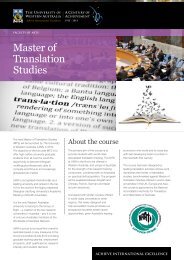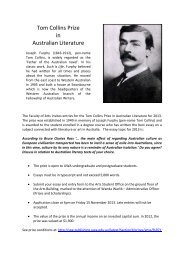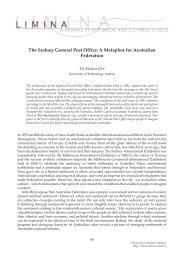'The Asia-Pacific Effect': Geo-Cultural Grouping at the ... - Past volumes
'The Asia-Pacific Effect': Geo-Cultural Grouping at the ... - Past volumes
'The Asia-Pacific Effect': Geo-Cultural Grouping at the ... - Past volumes
Create successful ePaper yourself
Turn your PDF publications into a flip-book with our unique Google optimized e-Paper software.
Limina, Volume 13, 2007<br />
Lisa Chandler<br />
‘The <strong>Asia</strong>-<strong>Pacific</strong> Effect’: <strong>Geo</strong>-<strong>Cultural</strong> <strong>Grouping</strong> <strong>at</strong> <strong>the</strong> <strong>Asia</strong>-<br />
<strong>Pacific</strong> Triennials<br />
Lisa Chandler<br />
University of <strong>the</strong> Sunshine Coast<br />
The opening of Brisbane’s new Gallery of Modern Art in December 2006 reflects <strong>the</strong> substantial growth<br />
of <strong>the</strong> Queensland Art Gallery (QAG) in both size and st<strong>at</strong>us over <strong>the</strong> last two decades. The Gallery has<br />
been recognised n<strong>at</strong>ionally and intern<strong>at</strong>ionally for its leading role in <strong>the</strong> present<strong>at</strong>ion of <strong>the</strong> <strong>Asia</strong>-<strong>Pacific</strong><br />
Triennials of Contemporary Art, and its significant collection of art from <strong>the</strong> region will hold a prominent<br />
place in <strong>the</strong> expanded institution. Twenty years ago, however, <strong>the</strong> Gallery seemed an unlikely candid<strong>at</strong>e<br />
to concentr<strong>at</strong>e on such work, so wh<strong>at</strong> are <strong>the</strong> reasons for this dram<strong>at</strong>ic change? This paper examines how<br />
QAG’s decision to focus on <strong>the</strong> geo-cultural c<strong>at</strong>egory of ‘<strong>Asia</strong>-<strong>Pacific</strong>’ art cre<strong>at</strong>ed a distinctive grouping<br />
which enabled <strong>the</strong> Gallery to distinguish itself from o<strong>the</strong>r institutions. It also considers <strong>the</strong> implic<strong>at</strong>ions for<br />
artists in being represented within this cur<strong>at</strong>orial classific<strong>at</strong>ion.<br />
In December 2006, <strong>the</strong> Fifth <strong>Asia</strong>-<strong>Pacific</strong> Triennial of Contemporary Art – APT5 – was presented as<br />
<strong>the</strong> opening exhibition <strong>at</strong> Brisbane’s new Gallery of Modern Art (GoMA), when <strong>the</strong> Queensland<br />
Art Gallery (QAG) expanded into a single two-site institution. With <strong>the</strong> opening of GoMA, <strong>the</strong><br />
two-site Queensland Art Gallery became ‘<strong>the</strong> second largest public art museum in Australia’. 1 The<br />
addition to <strong>the</strong> existing Gallery has been established to house <strong>the</strong> institution’s expanding collections,<br />
including its significant holdings of contemporary <strong>Asia</strong>n and <strong>Pacific</strong> art. Director Doug Hall claims<br />
th<strong>at</strong> <strong>the</strong> new building, which is double <strong>the</strong> size of <strong>the</strong> existing Gallery, is a reward ‘for our own<br />
success’. 2 Since <strong>the</strong> present<strong>at</strong>ion of <strong>the</strong> First <strong>Asia</strong>-<strong>Pacific</strong> Triennial of Contemporary Art (First APT) in<br />
1993, QAG has gained n<strong>at</strong>ional and intern<strong>at</strong>ional prominence by establishing an exhibition and<br />
acquisition focus on art from <strong>the</strong> <strong>Asia</strong>-<strong>Pacific</strong> region, yet twenty years ago, <strong>the</strong> Gallery seemed an<br />
unlikely candid<strong>at</strong>e to concentr<strong>at</strong>e on such work. Although it was not <strong>the</strong> only Australian institution<br />
involved in presenting contemporary art from <strong>the</strong> region in <strong>the</strong> 1990s, QAG’s decision to distinguish<br />
itself by collecting and exhibiting <strong>the</strong> art of this constructed geo-cultural grouping has substantially<br />
benefited <strong>the</strong> institution as well as many artists from <strong>the</strong> region.<br />
When QAG presented <strong>the</strong> First APT in 1993, Caroline Turner, Deputy Director and Manager<br />
(Intern<strong>at</strong>ional Programs) stressed th<strong>at</strong> <strong>the</strong> notion of ‘<strong>Asia</strong>-<strong>Pacific</strong>’ is a constructed one. Turner<br />
observed th<strong>at</strong> <strong>the</strong> use of <strong>the</strong> term ‘does not refer to any perceived homogeneity among countries<br />
of <strong>the</strong> region, but it is used in a purely geographical sense. There is no collective <strong>Asia</strong>n identity, let<br />
alone an <strong>Asia</strong>-<strong>Pacific</strong> identity.’ 3 Never<strong>the</strong>less <strong>the</strong>re were advantages for <strong>the</strong> Gallery in concentr<strong>at</strong>ing<br />
on this collective cultural grouping and <strong>the</strong> Triennials have been central to <strong>the</strong> institution’s move<br />
into this collection sphere. They have engendered a substantial discourse encompassing both praise<br />
and criticism for <strong>the</strong> Gallery as it has negoti<strong>at</strong>ed <strong>the</strong> thorny terrain of representing dispar<strong>at</strong>e cultural<br />
perspectives through <strong>the</strong> APTs. A recurring deb<strong>at</strong>e has centred on <strong>the</strong> merits of organising an<br />
exhibition based on a geo-cultural grouping and <strong>the</strong> <strong>at</strong>tendant emphases on n<strong>at</strong>ion and ethnicity<br />
th<strong>at</strong> this implies. As QAG presents <strong>the</strong> Fifth Triennial which, like APT 2002, differs from <strong>the</strong> first<br />
three exhibitions in <strong>the</strong> series, this paper considers <strong>the</strong> impact of <strong>the</strong> First APT and examines some of<br />
34<br />
© The Limina Editorial Collective<br />
http://limina.arts.uwa.edu.au
Limina, Volume 13, 2007<br />
Lisa Chandler<br />
<strong>the</strong> implic<strong>at</strong>ions of <strong>the</strong> Gallery’s decision to present artwork in <strong>the</strong> context of this collective ‘cultural<br />
whole’. ‘<strong>Asia</strong>-<strong>Pacific</strong>’ as a classific<strong>at</strong>ory grouping represents a form of difference from o<strong>the</strong>r cur<strong>at</strong>orial<br />
taxonomies. I will argue th<strong>at</strong> being aligned with such a grouping can be both advantageous and<br />
limiting for artists, while by foregrounding this distinctive c<strong>at</strong>egory QAG has accrued symbolic<br />
capital and successfully boosted its st<strong>at</strong>us within <strong>the</strong> artworld. 4<br />
A Project Waiting to be Done<br />
When QAG presented <strong>the</strong> First APT in 1993, this large survey exhibition, initially envisaged as<br />
<strong>the</strong> first in a series of three, was heralded as ‘a major breakthrough in Australia’s hi<strong>the</strong>rto p<strong>at</strong>chy<br />
rel<strong>at</strong>ionship with [contemporary] <strong>Asia</strong>-<strong>Pacific</strong> art’. 5 It garnered considerable <strong>at</strong>tention for <strong>the</strong><br />
Gallery and enabled QAG to develop a collection of contemporary <strong>Asia</strong>n and <strong>Pacific</strong> art, although<br />
initially <strong>the</strong> former collection area received far gre<strong>at</strong>er emphasis. In addition, <strong>the</strong> strength and<br />
degree of critical responses to <strong>the</strong> Triennial were indic<strong>at</strong>ions of <strong>the</strong> project’s impact on <strong>the</strong> artworld,<br />
particularly in Australia and <strong>Asia</strong>. At <strong>the</strong> time, though, <strong>the</strong> Triennial endeavour and QAG’s long<br />
term commitment to presenting art from <strong>the</strong> region represented both a sizeable opportunity and risk<br />
for <strong>the</strong> institution.<br />
The APTs offered <strong>the</strong> potential for <strong>the</strong> Gallery to make its mark in <strong>the</strong> artworld by identifying a<br />
niche collection area and responding to <strong>the</strong> under-represent<strong>at</strong>ion of contemporary <strong>Asia</strong>-<strong>Pacific</strong> art<br />
within Australian and o<strong>the</strong>r Western art institutions. When <strong>the</strong> First APT was launched, Director<br />
Doug Hall observed:<br />
Australia’s cultural engagement with <strong>Asia</strong> has, more often than not, been conceived as art history,<br />
both through exhibitions and <strong>the</strong> development of collections ... In many ways <strong>the</strong> Gallery saw <strong>the</strong><br />
development of <strong>the</strong> Triennial as a project waiting to be done. It broke <strong>the</strong> p<strong>at</strong>tern of art museums’<br />
preoccup<strong>at</strong>ion with <strong>the</strong> past; [and] defined a way, in both intellectual and organis<strong>at</strong>ional terms,<br />
in which Australia might construct a relevant forum for <strong>the</strong> present<strong>at</strong>ion of <strong>Asia</strong>n and <strong>Pacific</strong><br />
contemporary art. 6<br />
Hall’s discussion of a ‘project waiting to be done’ suggests th<strong>at</strong> conditions existed for an institution<br />
to take <strong>the</strong> initi<strong>at</strong>ive and distinguish itself by presenting contemporary <strong>Asia</strong>-<strong>Pacific</strong> art as a valuable<br />
area for exhibition and collection. Beyond <strong>the</strong> issue of any institutional benefits, Hall’s remarks also<br />
identified an important role <strong>the</strong> Gallery could play in giving gre<strong>at</strong>er prominence to contemporary<br />
art practice in <strong>the</strong> region. Even so, <strong>the</strong> Gallery was taking a chance in its substantial commitment<br />
to this ‘unconventional’ collection area. Although various institutional and individual endeavours,<br />
such as <strong>the</strong> Artists’ Regional Exchange (ARX) in Perth and <strong>Asia</strong>link in Melbourne, had been fostering<br />
interactions with artists in <strong>the</strong> region prior to <strong>the</strong> instig<strong>at</strong>ion of <strong>the</strong> First APT, contemporary <strong>Asia</strong>-<br />
<strong>Pacific</strong> art did not have a substantial presence in major Australian galleries in <strong>the</strong> early 1990s.<br />
Superficially, QAG appeared an unlikely candid<strong>at</strong>e to focus on such work because its holdings of<br />
<strong>Asia</strong>n and <strong>Pacific</strong> art were quite small. A move into this field might have seemed more probable from<br />
galleries with strong historical <strong>Asia</strong>n art collections, such as <strong>the</strong> Art Gallery of New South Wales, <strong>the</strong><br />
N<strong>at</strong>ional Gallery of Victoria, <strong>the</strong> Art Gallery of South Australia or <strong>the</strong> N<strong>at</strong>ional Gallery of Australia.<br />
Hall implies th<strong>at</strong> this was unlikely, however, because of a fixed focus on art from <strong>the</strong> past and a<br />
belief th<strong>at</strong> such work was inherently more valuable and hence more worthy of collection. There was<br />
also less impetus for some of <strong>the</strong> more prestigious art museums with well-established collections<br />
to venture into <strong>the</strong> somewh<strong>at</strong> undefined realm of contemporary <strong>Asia</strong>-<strong>Pacific</strong> art. One explan<strong>at</strong>ion<br />
for this disposition to preserve existing conditions is provided by Pierre Bourdieu who argues th<strong>at</strong><br />
it is preferable for successful institutions ‘to perpetu<strong>at</strong>e <strong>the</strong> st<strong>at</strong>us quo by maintaining <strong>the</strong>mselves<br />
and <strong>the</strong> principles on which <strong>the</strong>ir dominance is based … since <strong>the</strong>y are on top ... excellence <strong>the</strong>refore<br />
consists in being wh<strong>at</strong> one is’. 7<br />
Ironically, <strong>the</strong> limited n<strong>at</strong>ure of QAG’s overall holdings was a significant factor which contributed<br />
to <strong>the</strong> institution’s decision to foreground <strong>Asia</strong>-<strong>Pacific</strong> art. From <strong>the</strong> Gallery’s form<strong>at</strong>ion in 1895,<br />
issues such as a lack of permanent premises accompanied by limited staffing, funding and p<strong>at</strong>ronage<br />
had affected QAG’s ability to develop a comprehensive and distinctive collection compared to many<br />
35<br />
© The Limina Editorial Collective<br />
http://limina.arts.uwa.edu.au
Limina, Volume 13, 2007<br />
Lisa Chandler<br />
o<strong>the</strong>r Australian art museums. Hall points out th<strong>at</strong> <strong>the</strong> APT and ‘modern and contemporary <strong>Asia</strong>n<br />
collection would not have eventu<strong>at</strong>ed’ had he ‘inherited a continuity of collections’. He explains<br />
th<strong>at</strong> ‘[w]e couldn’t emul<strong>at</strong>e <strong>the</strong> fabulous historical <strong>Asia</strong>n collections of Melbourne and Sydney, so<br />
... we’ve had to think of ways to engage with <strong>the</strong> region as well as produce something unique in<br />
Australia’ [my italics]. 8 In 1987, when Hall joined <strong>the</strong> institution, QAG did not possess a legacy of<br />
n<strong>at</strong>ionally or intern<strong>at</strong>ionally acclaimed collection strengths so <strong>the</strong> opportunity existed for it to claim<br />
a ‘new’ or distinctive collection area and to boost its reput<strong>at</strong>ion in <strong>the</strong> process.<br />
Cre<strong>at</strong>ing Distinctions<br />
The Gallery’s actions in seeking to ‘produce something unique’, in o<strong>the</strong>r words, to distinguish itself<br />
from o<strong>the</strong>r Australian public galleries, reflect str<strong>at</strong>egies which Bourdieu’s account of <strong>the</strong> ‘field of<br />
cultural production’ assists us to clarify. Bourdieu envisages <strong>the</strong> artworld as a domain comprised<br />
of practices and rel<strong>at</strong>ionships constituting <strong>the</strong> physical and symbolic production, circul<strong>at</strong>ion and<br />
consumption of art, and proposes th<strong>at</strong> <strong>the</strong> cultural field is essentially rel<strong>at</strong>ional, as agents within it<br />
seek positions of gre<strong>at</strong>er prominence and undertake activity th<strong>at</strong> cre<strong>at</strong>es distinctions from o<strong>the</strong>rs. 9<br />
In this sphere, players are ‘positioned’ according to <strong>the</strong> degree of symbolic capital <strong>the</strong>y possess and<br />
this is characterised by <strong>the</strong> <strong>at</strong>tainment of st<strong>at</strong>us, recognition, authority and <strong>the</strong> power <strong>the</strong>y confer.<br />
In <strong>the</strong> case of <strong>the</strong> artworld, actions which cause an art museum to distinguish itself favourably from<br />
o<strong>the</strong>rs can accrue prestige and prominence for th<strong>at</strong> institution. Such initi<strong>at</strong>ives include representing<br />
<strong>the</strong> work of <strong>the</strong> most pre-eminent artists, and presenting and acquiring <strong>the</strong> work of artists or art<br />
movements ‘ahead of <strong>the</strong> game’. In addition, institutions with significant standing and symbolic<br />
capital possess gre<strong>at</strong>er authority to determine which practitioners remain or move into positions of<br />
importance. In this way, art museums invest particular forms of artistic production with value or<br />
belief in <strong>the</strong>ir value, and play an important role in legitimising some individuals or groups of artists<br />
over o<strong>the</strong>rs. 10<br />
In this domain, <strong>the</strong> impetus to shift positions inevitably comes from those with a lesser st<strong>at</strong>us,<br />
because agents with gre<strong>at</strong>est authority, ‘those who have made <strong>the</strong>ir mark’, have a vested interest in<br />
maintaining <strong>the</strong>ir dominant st<strong>at</strong>us. The ‘initi<strong>at</strong>ive of change falls’ on those ‘who are also those least<br />
endowed with specific capital’, and in order to ‘occupy a distinct, distinctive position, <strong>the</strong>y must<br />
assert <strong>the</strong>ir difference’. 11 Bourdieu argues th<strong>at</strong>:<br />
“Making one’s mark” … means winning recognition, in both senses, of one’s difference from<br />
o<strong>the</strong>r producers, especially <strong>the</strong> most consecr<strong>at</strong>ed of <strong>the</strong>m; it means, by <strong>the</strong> same token, cre<strong>at</strong>ing a<br />
new position, ahead of <strong>the</strong> positions already occupied, in <strong>the</strong> vanguard. (Hence <strong>the</strong> importance<br />
… of all distinctive marks, such things as <strong>the</strong> names of schools or groups – words which make<br />
things, distinctive signs which produce existence). 12<br />
For QAG, <strong>the</strong> prospect of ‘challenging’ larger and more prominent Australian public galleries by<br />
replic<strong>at</strong>ing and surpassing <strong>the</strong>ir collection strengths was not a feasible option. The Gallery sought to<br />
distinguish itself through difference, by looking for new or neglected areas for acquisition so it could<br />
be ‘ahead of <strong>the</strong> game’ and break from expected p<strong>at</strong>terns of collecting. Considered as a cultural<br />
whole, <strong>the</strong> ‘distinctive signs’ of <strong>Asia</strong>-<strong>Pacific</strong> art and an emphasis on regional and geographical<br />
groupings were a potential means of deline<strong>at</strong>ing such differences.<br />
Within <strong>the</strong> context of Bourdieu’s model, QAG’s commitment to <strong>Asia</strong>-<strong>Pacific</strong> art can thus be<br />
<strong>at</strong>tributed in part to an institutional disposition to boost <strong>the</strong> organis<strong>at</strong>ion’s trajectory and reput<strong>at</strong>ion,<br />
however, <strong>the</strong>re were numerous o<strong>the</strong>r reasons for <strong>the</strong> Gallery’s shift in direction from <strong>the</strong> l<strong>at</strong>e 1980s.<br />
In fact, QAG had previously considered <strong>the</strong> potential of developing distinctive collection areas<br />
incorpor<strong>at</strong>ing <strong>Asia</strong>-<strong>Pacific</strong> art, but <strong>the</strong>se proposals had not been realised due to <strong>the</strong> competing<br />
needs of o<strong>the</strong>r cur<strong>at</strong>orial spheres as well as staffing and funding shortages. 13 O<strong>the</strong>r factors needed<br />
to coalesce in order to facilit<strong>at</strong>e change <strong>at</strong> <strong>the</strong> Gallery. These included <strong>the</strong> vision and interests of<br />
particular individuals, <strong>the</strong> development of projects engaging with contemporary <strong>Asia</strong>n art, a revision<br />
36<br />
© The Limina Editorial Collective<br />
http://limina.arts.uwa.edu.au
Limina, Volume 13, 2007<br />
Lisa Chandler<br />
of acquisition policy and historically specific conditions of time and place which were all significant<br />
in contributing to <strong>the</strong> institution’s decision to focus on <strong>the</strong> collective grouping of <strong>Asia</strong>-<strong>Pacific</strong> art.<br />
Factors Facilit<strong>at</strong>ing Change<br />
A major c<strong>at</strong>alyst for this shift occurred in 1987 with <strong>the</strong> appointment of a new Board of Trustees,<br />
a new Chairman of Trustees, Richard Austin, and Doug Hall as Gallery Director. A substantial<br />
review of institutional structures and policies soon followed. In his inaugural public speech <strong>at</strong> <strong>the</strong><br />
institution, Austin emphasised <strong>the</strong> importance of QAG’s geographical position, declaring th<strong>at</strong> as ‘a<br />
gallery on <strong>the</strong> periphery of <strong>Asia</strong>’ it should ‘take account of’ <strong>the</strong> region’s art, although he also stressed<br />
<strong>the</strong> practical difficulties of such a str<strong>at</strong>egy, given <strong>the</strong> cost and availability of historical <strong>Asia</strong>n works<br />
and <strong>the</strong> existing strengths of o<strong>the</strong>r Australian galleries. 14 Austin’s words were not empty rhetoric,<br />
but r<strong>at</strong>her reflected his profound interest in and advocacy of <strong>Asia</strong>n art as an important collection<br />
area for <strong>the</strong> institution. Austin had extensive expertise and connections in <strong>Asia</strong>, particularly in Japan,<br />
was fluent in several <strong>Asia</strong>n languages, and was influential in promoting a major consciousness of<br />
<strong>Asia</strong> within <strong>the</strong> institution. 15<br />
While acknowledging Austin’s views and his preference for traditional <strong>Asia</strong>n art, Hall wished<br />
to develop <strong>the</strong> Gallery as a dynamic centre for contemporary art. In addition, Deputy Director and<br />
Manager of Intern<strong>at</strong>ional Programs Caroline Turner had been intrinsically involved in institutional<br />
exchanges and exhibitions of <strong>Asia</strong>n art up to this point, so <strong>the</strong>se individual visions contributed to<br />
a decision to foreground contemporary <strong>Asia</strong>-<strong>Pacific</strong> art. The Gallery still needed to determine how<br />
this new focus would be realised, so in revising its Acquisition Policy, QAG took into account ‘<strong>the</strong><br />
collecting policies of o<strong>the</strong>r St<strong>at</strong>e galleries’, 16 in its consider<strong>at</strong>ions of <strong>Asia</strong>n and <strong>Pacific</strong> art as potential<br />
‘new areas of collecting’. 17 Although <strong>the</strong> institution recognised ‘<strong>the</strong> important regional role’ it could<br />
play, it was not yet specific about <strong>the</strong> ‘extent to which <strong>the</strong> indigenous art of <strong>the</strong> <strong>Pacific</strong> and <strong>Asia</strong>n<br />
arts’ would be incorpor<strong>at</strong>ed within <strong>the</strong> collection. 18<br />
In <strong>the</strong> 1980s, a cur<strong>at</strong>orial exchange between QAG and <strong>the</strong> Museum of Modern Art in Saitama<br />
also provided a springboard for <strong>the</strong> Gallery’s engagement with art from <strong>the</strong> region and employed a<br />
model of co-cur<strong>at</strong>orship which subsequently influenced selection processes for <strong>the</strong> early APTs. This<br />
fruitful collabor<strong>at</strong>ion resulted in <strong>the</strong> present<strong>at</strong>ion of Japanese Ways, Western Means, a comprehensive<br />
exhibition fe<strong>at</strong>uring contemporary Japanese art held <strong>at</strong> QAG in 1989. 19 While <strong>the</strong> Gallery could have<br />
continued to present specialised displays drawing on <strong>the</strong> art of single n<strong>at</strong>ions, it opted instead for <strong>the</strong><br />
Triennial model. The grander scale of <strong>the</strong> three proposed ‘blockbuster’ shows would <strong>at</strong>tract gre<strong>at</strong>er<br />
<strong>at</strong>tention, and provide Brisbane’s response to major contemporary art initi<strong>at</strong>ives, such as <strong>the</strong> Sydney<br />
Biennale, instig<strong>at</strong>ed by o<strong>the</strong>r Australian art museums. If successful, <strong>the</strong> Triennials would signal <strong>the</strong><br />
Gallery’s claims as a player in <strong>the</strong> domain of contemporary <strong>Asia</strong>-<strong>Pacific</strong> art, enabling it to ‘make its<br />
mark’ and, in Bourdieu’s terms, to garner symbolic capital in <strong>the</strong> process. 20<br />
The Triennial series would be costly and complex to mount, however, and presented <strong>the</strong> institution<br />
with numerous challenges, such as overcoming its limited knowledge of and connections with<br />
practitioners in <strong>the</strong> region. In 1990, Turner surmised th<strong>at</strong> ‘[m]y own belief is th<strong>at</strong> it will take 10 years<br />
for us to feel confident in <strong>the</strong>se rel<strong>at</strong>ionships and in our engagement with <strong>the</strong> art of <strong>the</strong> region.’ 21 The<br />
Gallery’s initial decision to stage three Triennials demonstr<strong>at</strong>ed its commitment to presenting <strong>Asia</strong>-<br />
<strong>Pacific</strong> art, and while this certainly helped to legitimise QAG’s move into this domain, motiv<strong>at</strong>ions<br />
beyond institutional self-interest contributed to <strong>the</strong> Gallery’s resolve. QAG’s long-term undertaking<br />
was also an important means of valuing and de-marginalising contemporary <strong>Asia</strong>-<strong>Pacific</strong> art. In<br />
addition, <strong>the</strong> institution sought to elimin<strong>at</strong>e gaps in both public and disciplinary knowledge and<br />
to a gre<strong>at</strong>er understanding of regional art practice. This was evidenced from <strong>the</strong> First APT in <strong>the</strong><br />
Gallery’s <strong>at</strong>tention to a range of areas beyond <strong>the</strong> exhibition itself, including <strong>the</strong> present<strong>at</strong>ion of an<br />
associ<strong>at</strong>ed conference, scholarly public<strong>at</strong>ions, substantial educ<strong>at</strong>ional programs, artist and cur<strong>at</strong>ors’<br />
talks and <strong>the</strong> development of a library research collection dedic<strong>at</strong>ed to <strong>Asia</strong>-<strong>Pacific</strong> art.<br />
Historically specific conditions of time and place were additional factors which enabled <strong>the</strong> QAG<br />
to benefit from an <strong>Asia</strong>-<strong>Pacific</strong> collection focus, as government economic and cultural initi<strong>at</strong>ives in<br />
37<br />
© The Limina Editorial Collective<br />
http://limina.arts.uwa.edu.au
Limina, Volume 13, 2007<br />
Lisa Chandler<br />
<strong>the</strong> region were being promoted <strong>at</strong> this time. Although political rhetoric was positioning Australia<br />
as part of <strong>Asia</strong>, <strong>the</strong> Gallery ‘concentr<strong>at</strong>ed on <strong>the</strong> <strong>Asia</strong>-<strong>Pacific</strong> so th<strong>at</strong> Australia can be included in this<br />
grouping’ 22 and because <strong>the</strong> project could more justifiably be initi<strong>at</strong>ed by an Australian institution.<br />
It also provided a point of difference from existing survey exhibitions of contemporary <strong>Asia</strong>n art<br />
such as <strong>the</strong> Fukuoka expositions in Japan. Although o<strong>the</strong>r Australian art institutions had presented<br />
exhibitions of contemporary <strong>Asia</strong>n art in <strong>the</strong> early 1990s, <strong>the</strong> Triennial concept reflected a more<br />
sustained commitment to collecting and exhibiting art from <strong>the</strong> region. Around this time, <strong>the</strong> Sydney<br />
Biennale management considered a proposal from <strong>Asia</strong>link Visual Arts Manager Alison Carroll to<br />
fe<strong>at</strong>ure contemporary <strong>Asia</strong>n art but opted to continue with its existing model, so <strong>the</strong> opportunity<br />
existed for QAG to differenti<strong>at</strong>e itself by foregrounding art from <strong>the</strong> region. 23<br />
Growing economic and trade ties between Australia and <strong>Asia</strong> cre<strong>at</strong>ed an environment in<br />
which <strong>the</strong> Gallery could profit in both symbolic and financial terms, because funding bodies were<br />
more readily disposed to support projects incorpor<strong>at</strong>ing artists from <strong>the</strong> <strong>Asia</strong>-<strong>Pacific</strong> region. The<br />
Australia Council’s re-organis<strong>at</strong>ion of its funding preferences to alloc<strong>at</strong>e an increasing portion of<br />
its intern<strong>at</strong>ional projects budget for <strong>Asia</strong>n or <strong>Pacific</strong>-oriented initi<strong>at</strong>ives in <strong>the</strong> early 1990s, is an<br />
example of <strong>the</strong>se shifting priorities. Consequently, QAG was successful in obtaining substantial<br />
grants from <strong>the</strong> organis<strong>at</strong>ion’s Visual Arts/Crafts Board to facilit<strong>at</strong>e <strong>the</strong> development of <strong>the</strong> First<br />
APT. 24 Sizeable financial support also came from <strong>the</strong> Queensland Government which saw <strong>the</strong> project<br />
as enhancing both <strong>the</strong> Gallery’s and its own rel<strong>at</strong>ionships with <strong>the</strong> region. 25 In addition, QAG’s<br />
Exhibition Development Fund, initi<strong>at</strong>ed in 1989 and consisting of significant contributions from<br />
Japanese corpor<strong>at</strong>ions with business interests in Australia and m<strong>at</strong>ched by Queensland Government<br />
subsidies, provided <strong>the</strong> institution with important seed funding for <strong>the</strong> Triennial endeavour. 26<br />
There were fur<strong>the</strong>r, more intangible benefits for QAG in developing a str<strong>at</strong>egic commitment to<br />
presenting <strong>Asia</strong>-<strong>Pacific</strong> art. As <strong>Asia</strong>n economies prospered, <strong>the</strong> region was viewed not only as a<br />
ground for fruitful economic and cultural enterprises, but in <strong>the</strong> Australian imaginary it was also being<br />
associ<strong>at</strong>ed with positive notions of dynamism, energy and growth. In <strong>the</strong> early 1990s, Prime Minister<br />
Paul Ke<strong>at</strong>ing linked <strong>the</strong> Republican deb<strong>at</strong>e and Australia’s ‘<strong>Asia</strong>n Turn’, arguing th<strong>at</strong> Australia’s<br />
future lay with <strong>Asia</strong> and not with <strong>the</strong> tired ties to <strong>the</strong> British monarchy. David Walker suggests th<strong>at</strong><br />
this rhetoric reflected a narr<strong>at</strong>ive of Australian cultural renewal so th<strong>at</strong> <strong>Asia</strong> was seen as ‘<strong>the</strong> c<strong>at</strong>alyst<br />
we needed to break <strong>the</strong> mould of <strong>the</strong> past and project a new future’. 27 Against this background,<br />
a major Gallery project engaging with <strong>the</strong> region could be seen as aligned with <strong>the</strong>se affirm<strong>at</strong>ive<br />
ideas of innov<strong>at</strong>ion and dynamism, and thus functioned as a symbolically profitable move for <strong>the</strong><br />
institution, while also playing an important role in giving gre<strong>at</strong>er prominence to <strong>Asia</strong>n and <strong>Pacific</strong> art.<br />
Represent<strong>at</strong>ion by N<strong>at</strong>ion<br />
When Queensland Premier Wayne Goss officially opened <strong>the</strong> First APT in September 1993, most of<br />
<strong>the</strong> Gallery’s spaces were taken up by Triennial artworks and <strong>the</strong> substantial number of install<strong>at</strong>ions<br />
contributed to <strong>the</strong> monumental sense of scale conveyed by <strong>the</strong> entire exhibition. The display<br />
included over two hundred works by seventy-six artists from twelve countries. Artists, writers and<br />
cur<strong>at</strong>ors <strong>at</strong>tended <strong>the</strong> opening celebr<strong>at</strong>ions and <strong>the</strong> scope, activity and ‘freshness’ of <strong>the</strong> exhibition<br />
and associ<strong>at</strong>ed programs invested <strong>the</strong> opening days with ‘sense of excitement’ and dynamism,<br />
gener<strong>at</strong>ing for many visitors ‘a life and an energy th<strong>at</strong> have not often been as palpable in <strong>the</strong> Gallery<br />
before’. 28 On many levels <strong>the</strong> First APT represented a significant achievement for QAG, but despite<br />
considerable popular and critical success, <strong>the</strong> Gallery also faced criticism for some of its approaches.<br />
While QAG was benefiting from foregrounding <strong>Asia</strong>-<strong>Pacific</strong> art, <strong>the</strong> organis<strong>at</strong>ion of <strong>the</strong> First APT<br />
as an exhibition unconnected by <strong>the</strong>me and structured around n<strong>at</strong>ional groupings was problem<strong>at</strong>ic<br />
in many ways. The survey model facilit<strong>at</strong>ed <strong>the</strong> display of a large selection of varied work through<br />
which viewers could familiarise <strong>the</strong>mselves with <strong>the</strong> diversity of regional practice. An organis<strong>at</strong>ional<br />
framework based on n<strong>at</strong>ion was one way of imposing structure on <strong>the</strong> dispar<strong>at</strong>e array of works,<br />
however, this emphasis on n<strong>at</strong>ion – within <strong>the</strong> c<strong>at</strong>alogue, <strong>the</strong> selection process, and to a large extent<br />
through display – risked oversimplifying and essentialising works as synecdoches of n<strong>at</strong>ion. This<br />
38<br />
© The Limina Editorial Collective<br />
http://limina.arts.uwa.edu.au
Limina, Volume 13, 2007<br />
Lisa Chandler<br />
could be seen in critical commentary which centred on exclusions of countries r<strong>at</strong>her than individual<br />
artists. QAG was admonished for <strong>the</strong> under-represent<strong>at</strong>ion of art from <strong>the</strong> <strong>Pacific</strong> and its ‘token<br />
represent<strong>at</strong>ion of areas such as Hong Kong, Papua New Guinea, Singapore and Vietnam’, while <strong>the</strong>re<br />
were fur<strong>the</strong>r concerns about <strong>the</strong> lack of inclusion of work from <strong>the</strong> Indian sub-continent, Burma, Sri<br />
Lanka and Taiwan. 29 In addition, a confidential survey of event participants revealed concerns about<br />
‘<strong>the</strong> numbers alloc<strong>at</strong>ed to each country’ and while artists’ feedback regarding cur<strong>at</strong>orial philosophy<br />
and display was ‘highly favourable … some suggested more mingling of artists’ work and a non<br />
n<strong>at</strong>ional approach’. 30<br />
Hall claims th<strong>at</strong> <strong>the</strong> selected countries were chosen for pragm<strong>at</strong>ic reasons involving existing<br />
connections and logistical m<strong>at</strong>ters. Never<strong>the</strong>less, <strong>the</strong>se criticisms highlight <strong>the</strong> problem of presenting<br />
an exhibition drawn from a ‘constructed’ geographical region and perpetu<strong>at</strong>e perceptions th<strong>at</strong> artists<br />
were selected as represent<strong>at</strong>ives of n<strong>at</strong>ion. 31 Although this was not QAG’s intention, Turner admitted<br />
th<strong>at</strong> approaching <strong>the</strong> exhibition ‘through n<strong>at</strong>ional contexts … raises significant questions’, adding ‘it<br />
is our hope th<strong>at</strong> fur<strong>the</strong>r countries be included in <strong>the</strong> next Triennial. In <strong>the</strong> future art may be selected<br />
o<strong>the</strong>r than n<strong>at</strong>ionally’. 32 In structuring <strong>the</strong> exhibition around <strong>Asia</strong>-<strong>Pacific</strong> art, a balance needed to be<br />
found between <strong>the</strong> extremes of essentialising artists and <strong>the</strong>ir work as somehow represent<strong>at</strong>ive of<br />
<strong>the</strong>ir country of origin, and considering such art only in terms of global art practice while ignoring<br />
local specificities. Them<strong>at</strong>ic organis<strong>at</strong>ion, cross-cultural rel<strong>at</strong>ionships, and altern<strong>at</strong>ive groupings of<br />
works were all possible solutions to <strong>the</strong>se difficult present<strong>at</strong>ion issues.<br />
Despite <strong>the</strong> criticisms, <strong>the</strong> Triennial project contributed to <strong>the</strong> valid<strong>at</strong>ion of contemporary <strong>Asia</strong>-<br />
<strong>Pacific</strong> art as a ‘collective whole’ within <strong>the</strong> broader context of intern<strong>at</strong>ional art, a point th<strong>at</strong> Malay<br />
artist and critic Redza Piyadasa expounded in a series of articles coinciding with <strong>the</strong> First APT.<br />
Piyadasa argued th<strong>at</strong> Euro-American centres of power had largely ignored <strong>Asia</strong>n modern and<br />
contemporary art in art historical discourse. He suggested th<strong>at</strong> <strong>the</strong> significance of <strong>the</strong> APT was<br />
its break with Euro-American artistic hegemony and commended QAG for choosing ‘to fur<strong>the</strong>r<br />
legitimise <strong>the</strong> modern artists of <strong>the</strong> <strong>Asia</strong>-<strong>Pacific</strong> countries’. Piyadasa does not argue th<strong>at</strong> modern<br />
and contemporary art from <strong>the</strong> region had no st<strong>at</strong>us prior to <strong>the</strong> Triennial but suggests th<strong>at</strong> in <strong>the</strong><br />
field of Western art discourse, particularly within Australia, QAG played a major role in valid<strong>at</strong>ing<br />
contemporary <strong>Asia</strong>-<strong>Pacific</strong> art and boosting its trajectory in this domain. 33<br />
Gaining Recognition<br />
QAG had taken a significant risk in committing to both <strong>the</strong> Triennial project and acquiring<br />
contemporary <strong>Asia</strong>-<strong>Pacific</strong> art, and while it had been criticised for some of its approaches, <strong>the</strong><br />
Gallery’s efforts contributed to <strong>the</strong> processes of ‘making a name for itself’ and gaining recognition<br />
in <strong>the</strong> field. 34 Many writers and participants praised <strong>the</strong> institution for its actions and a year after <strong>the</strong><br />
event Piyadasa claimed <strong>the</strong> Triennial ‘has earned for QAG a new and enviable reput<strong>at</strong>ion as a truly<br />
innov<strong>at</strong>ive art museum within <strong>the</strong> <strong>Asia</strong>-<strong>Pacific</strong> region. Its intern<strong>at</strong>ional reput<strong>at</strong>ion has certainly been<br />
considerably enhanced’. 35 An extensive discourse was gener<strong>at</strong>ed by <strong>the</strong> project and in a Gallery<br />
report summarising critical responses, N<strong>at</strong>alie King concludes: ‘On balance, <strong>the</strong> opinions expressed<br />
in reviews are positive with a general consensus th<strong>at</strong> <strong>the</strong> scale and contents of <strong>the</strong> project signalled<br />
initi<strong>at</strong>ive and marked an ambitious development in <strong>the</strong> present<strong>at</strong>ion of contemporary art from <strong>the</strong><br />
<strong>Asia</strong>-<strong>Pacific</strong> region.’ 36 In addition <strong>the</strong>re were strong <strong>at</strong>tendances <strong>at</strong> both <strong>the</strong> exhibition and rel<strong>at</strong>ed<br />
conference. These factors demonstr<strong>at</strong>e th<strong>at</strong> QAG’s activities in foregrounding contemporary <strong>Asia</strong>-<br />
<strong>Pacific</strong> art as a distinctive grouping, allowing it to ‘establish difference’ from o<strong>the</strong>r institutions, had<br />
succeeded in <strong>at</strong>tracting considerable <strong>at</strong>tention. The kudos gained through present<strong>at</strong>ion of <strong>the</strong> APT<br />
enabled QAG to accrue symbolic capital as it grew in st<strong>at</strong>ure as a credible venue for <strong>the</strong> collection<br />
and present<strong>at</strong>ion of dynamic contemporary art from <strong>the</strong> region. 37<br />
In spite of <strong>the</strong> increasing presence of art from <strong>the</strong> region in temporary exhibitions in Australian<br />
art museums, QAG was <strong>the</strong> first such institution to establish <strong>Asia</strong>-<strong>Pacific</strong> art as a dedic<strong>at</strong>ed collection<br />
area. Hall expressed <strong>the</strong> hope th<strong>at</strong> this unorthodox move would enable <strong>the</strong> institution to gain<br />
prominence in <strong>the</strong> field and he was assisted in this aim when The Myer Found<strong>at</strong>ion and Michael<br />
39<br />
© The Limina Editorial Collective<br />
http://limina.arts.uwa.edu.au
Limina, Volume 13, 2007<br />
Lisa Chandler<br />
and Anne Gamble Myer provided a major financial don<strong>at</strong>ion which allowed <strong>the</strong> fledgling collection<br />
to expand considerably. 38 By 1995, Anna Clabburn observed th<strong>at</strong> despite starting ‘with a rel<strong>at</strong>ively<br />
small historical collection, Queensland set one of <strong>the</strong> most progressive agendas in <strong>the</strong> country in 1993<br />
when it decided to collect contemporary <strong>Asia</strong>n art’. Clabburn adds th<strong>at</strong> following <strong>the</strong> First APT’s<br />
success ‘some cur<strong>at</strong>ors have signalled <strong>the</strong>ir intention to collect contemporary work although this<br />
is still a very fresh frontier’. 39 QAG’s focus on contemporary <strong>Asia</strong>-<strong>Pacific</strong> art was unusual because<br />
it emphasised a cur<strong>at</strong>orial c<strong>at</strong>egory th<strong>at</strong> did not exist in Australian galleries <strong>at</strong> this time. Although<br />
several art museums employed a Cur<strong>at</strong>or of <strong>Asia</strong>n Art, <strong>the</strong> c<strong>at</strong>egory of ‘Contemporary <strong>Asia</strong>-<strong>Pacific</strong><br />
Art’ did not readily fit into established structures existing in such institutions. The opportunity for<br />
collection development facilit<strong>at</strong>ed by <strong>the</strong> Triennials and <strong>the</strong> Gallery’s efforts to differenti<strong>at</strong>e itself<br />
from o<strong>the</strong>r institutions enabled QAG to break with this established practice and to build a distinctive<br />
collection ‘ahead of <strong>the</strong> game’. This has subsequently been built into a collection of intern<strong>at</strong>ional<br />
significance which will be highlighted <strong>at</strong> GoMA.<br />
When <strong>the</strong> Second APT was presented in 1996, <strong>the</strong> issue of artist represent<strong>at</strong>ion within an <strong>Asia</strong>-<br />
<strong>Pacific</strong> grouping was one of <strong>the</strong> many issues deb<strong>at</strong>ed in discourse eman<strong>at</strong>ing from <strong>the</strong> event. The<br />
sense of ‘newness’ or first-time encounter remarked upon <strong>at</strong> <strong>the</strong> first exhibition was played down <strong>at</strong><br />
<strong>the</strong> second. Nick Jose, for example, suggested th<strong>at</strong> many of <strong>the</strong> selected artists had reached a position<br />
of orthodoxy in intern<strong>at</strong>ional ‘circuits of exchange’ and th<strong>at</strong> ‘contemporary art of <strong>the</strong> <strong>Pacific</strong>, as <strong>the</strong><br />
youngest arrival, took <strong>the</strong> avant-garde mantle for this APT’. 40 Certainly, while some artists were<br />
already acclaimed within <strong>the</strong> intern<strong>at</strong>ional arena, this was not <strong>the</strong> case for all APT practitioners,<br />
many of whom were seeking to achieve recognition beyond <strong>the</strong>ir own immedi<strong>at</strong>e area. American<br />
critic Judith Stein’s comments th<strong>at</strong>, ‘apart from work by <strong>the</strong> few Japanese and Chinese artists who<br />
had previously exhibited in Venice and New York, <strong>the</strong> art was entirely new to me’ suggest th<strong>at</strong> <strong>the</strong><br />
Triennials were playing a valuable role in contributing to <strong>the</strong> recognition and legitimis<strong>at</strong>ion of <strong>the</strong><br />
work of many artists from <strong>the</strong> region. 41<br />
The increased <strong>at</strong>tention given to artists <strong>at</strong> <strong>the</strong> APTs raised <strong>the</strong> complex issue of represent<strong>at</strong>ion as<br />
part of a constructed ‘cultural whole.’ Jose notes th<strong>at</strong> some Triennial visitors ‘complained th<strong>at</strong> <strong>the</strong><br />
APT was damaging itself by stressing regionalism <strong>at</strong> <strong>the</strong> expense of quality and conceptual clarity’. 42<br />
This perspective centres on <strong>the</strong> view, expressed by South Korean cur<strong>at</strong>or Soyeon Ahn, th<strong>at</strong> ‘n<strong>at</strong>ional<br />
identity should hide itself under <strong>the</strong> brilliant individuality of each artist’, or th<strong>at</strong> practitioners should<br />
be recognised on <strong>the</strong> basis of <strong>the</strong>ir individual talent and not <strong>the</strong>ir cultural background. 43 Ideally this<br />
would be <strong>the</strong> case, and certainly many artists from outside Euro-American art centres have been<br />
acknowledged in <strong>the</strong>ir own right without being presented as part of a focused regional or cultural<br />
grouping. Never<strong>the</strong>less, <strong>the</strong> structures of <strong>the</strong> artworld oper<strong>at</strong>e so th<strong>at</strong> it is necessary to ‘gain entry’<br />
into exhibition circuits in order to have artistic excellence recognised, and <strong>the</strong>se processes are not<br />
always ‘democr<strong>at</strong>ic’ and globally inclusive. The practical realities of continuing Euro-American<br />
domin<strong>at</strong>ion of <strong>the</strong> intern<strong>at</strong>ional contemporary artworld mean th<strong>at</strong> while gre<strong>at</strong>er opportunities<br />
now exist for intern<strong>at</strong>ional exposure, it is harder for artists far from art centres to have <strong>the</strong>ir work<br />
regularly seen by those in positions of power with <strong>the</strong> ability to consecr<strong>at</strong>e artists and artworks<br />
through exhibition, collection and discourse.<br />
The benefits of exhibiting in <strong>the</strong> <strong>Asia</strong>-<strong>Pacific</strong> Triennial were remarked on by many of <strong>the</strong><br />
particip<strong>at</strong>ing artists. Indonesian artist Marintan Sirait noted th<strong>at</strong> ‘a lot of participants, especially<br />
myself, might have difficulties in joining o<strong>the</strong>r events/exhibitions’ while Michael Mel remarked<br />
th<strong>at</strong> ‘[w]e are gr<strong>at</strong>eful for <strong>the</strong> opportunity to present our art as we present it in Papua New Guinea<br />
… our performances have not been given <strong>the</strong> same opportunities overseas.’ Thai practitioner Kamin<br />
Lertchaiprasert commented th<strong>at</strong> ‘I have learnt a gre<strong>at</strong> deal from o<strong>the</strong>r colleagues … and it was a<br />
wonderful experience for my career as an artist.’ O<strong>the</strong>rs stressed <strong>the</strong> impact of <strong>the</strong> event on <strong>the</strong><br />
region. Vivian Sundaram described <strong>the</strong> APT as ‘a very special coming toge<strong>the</strong>r of wh<strong>at</strong> we consider<br />
to be <strong>the</strong> “beginnings” of a very dynamic art movement … The avant-garde is here’, while Jose<br />
Tence Ruiz surmised th<strong>at</strong> events such as <strong>the</strong> APT result in a ‘more vigorous inter-<strong>Asia</strong>n scene, a long<br />
overdue re-orient<strong>at</strong>ion of parochial tendencies … and a shift in value applic<strong>at</strong>ion’. 44 Thus, although<br />
<strong>the</strong> Triennials’ focus on n<strong>at</strong>ional-cultural represent<strong>at</strong>ion was problem<strong>at</strong>ic in some ways, <strong>the</strong> project<br />
40<br />
© The Limina Editorial Collective<br />
http://limina.arts.uwa.edu.au
Limina, Volume 13, 2007<br />
Lisa Chandler<br />
was beneficial in providing a forum, growing in terms of recognition and legitimacy, enabling critics,<br />
historians and artists to become familiar with <strong>the</strong> work of practitioners from <strong>the</strong> region.<br />
The ‘<strong>Asia</strong>-<strong>Pacific</strong> Effect’<br />
In <strong>the</strong> 1990s, <strong>the</strong> APT series coincided with <strong>the</strong> development of a number of o<strong>the</strong>r large-scale<br />
intern<strong>at</strong>ional exhibitions showcasing work from artists outside Euro-American art centres. Toge<strong>the</strong>r<br />
<strong>the</strong>y cre<strong>at</strong>ed an altern<strong>at</strong>ive art circuit for practitioners who may have been excluded from similar events<br />
in Europe and America, while also providing a conduit to such prestigious intern<strong>at</strong>ional exhibitions.<br />
Collectively <strong>the</strong>se ‘non-mainstream’ enterprises, loc<strong>at</strong>ed in de-centralised, predominantly non-<br />
Western cities, established a counter discourse to dominant Western art hegemonies and <strong>the</strong> APTs,<br />
with <strong>the</strong>ir geo-cultural emphasis, played a role in this ongoing activity of de-centring contemporary<br />
art practice. In considering <strong>the</strong> impact of <strong>the</strong> Triennials and o<strong>the</strong>r regional events, Jen Webb refers<br />
to wh<strong>at</strong> she terms <strong>the</strong> ‘<strong>Asia</strong>-<strong>Pacific</strong> effect’. Webb reasons th<strong>at</strong> although <strong>Asia</strong>-<strong>Pacific</strong> is a constructed<br />
region, because it has been cre<strong>at</strong>ed ‘in language by powerful … n<strong>at</strong>ional and geopolitical entities<br />
… <strong>the</strong>re is an effect of <strong>Asia</strong>-<strong>Pacific</strong> which allows us to talk about it as a Real thing.’ This collective<br />
<strong>Asia</strong>-<strong>Pacific</strong> effect has cre<strong>at</strong>ed a space of power offering regional artists <strong>the</strong> ability ‘to represent<br />
<strong>the</strong>mselves r<strong>at</strong>her than be represented by old colonialist p<strong>at</strong>terns and practices.’ Webb concludes<br />
th<strong>at</strong> ‘because it is being gener<strong>at</strong>ed by powerful … institutions, agents and practices,’ <strong>the</strong> <strong>Asia</strong>-<strong>Pacific</strong><br />
effect establishes a domain in which regional artists, cur<strong>at</strong>ors and critics ‘can claim a legitim<strong>at</strong>ed<br />
voice … and challenge <strong>the</strong> hegemony of “Euramerican” narr<strong>at</strong>ives, values and aes<strong>the</strong>tics.’ 45<br />
While <strong>the</strong>re are advantages in collective represent<strong>at</strong>ion, for practitioners oper<strong>at</strong>ing outside art<br />
‘centres’ <strong>the</strong>re is a tension between garnering benefits by being presented as part of a n<strong>at</strong>ional or<br />
cultural grouping, and having one’s art viewed in and of itself. Niranjan Rajah, whose work was<br />
exhibited <strong>at</strong> <strong>the</strong> Second APT, remarked:<br />
As an artist who represents himself, I am delighted <strong>at</strong> <strong>the</strong> widening field of visibility and will,<br />
surely, <strong>at</strong>tempt to exploit its possibilities. However, as an art historian and <strong>the</strong>orist who …<br />
“represents” <strong>the</strong> art of his country, I feel <strong>the</strong> need to urge caution … It is important th<strong>at</strong> in <strong>the</strong><br />
“synchrony” of <strong>the</strong>ir engagement with <strong>the</strong> intern<strong>at</strong>ional scene, our contemporary artists take care<br />
not to detach <strong>the</strong>mselves from <strong>the</strong> “diachrony” of Malaysian art history. 46<br />
Rajah acknowledges <strong>the</strong> tangible benefits of increased artworld prominence but expresses concern<br />
th<strong>at</strong> artists’ works are understood and situ<strong>at</strong>ed within <strong>the</strong>ir origin<strong>at</strong>ing context, so <strong>the</strong> question of<br />
how artists represent <strong>the</strong>mselves and how <strong>the</strong>y are c<strong>at</strong>egorised by art institutions is a complex one<br />
and may shift in different circumstances. At <strong>the</strong> Second APT, a grouping of indigenous Australian<br />
and <strong>Pacific</strong> artists was grouped collectively as ‘<strong>Pacific</strong> Peoples’ in order ‘to represent <strong>the</strong>mselves’,<br />
allowing ‘a right of reply to <strong>the</strong> imposition of Western ways of seeing’. 47 All Stock Must Go! (1996) an<br />
install<strong>at</strong>ion and performance by <strong>the</strong> Campfire Group, a collective of primarily indigenous Australian<br />
artists, included a c<strong>at</strong>tle truck parked outside QAG’s entrance, overflowing with items of Aboriginal<br />
art available for sale. In this instance, <strong>the</strong> artists deliber<strong>at</strong>ely chose to loc<strong>at</strong>e <strong>the</strong>ir work outside <strong>the</strong><br />
Gallery, both literally and metaphorically. For many artists, however, it is important to be presented<br />
‘both ways,’ or r<strong>at</strong>her, in multiple ways so as not to be envisaged in terms of cultural essences since<br />
‘difference’ is flexible and fluid and thus unable to be constrained by rigid cultural distinctions.<br />
The Triennials and <strong>the</strong> discourse engendered by <strong>the</strong>m provided a forum through which such issues<br />
could be played out, and in presenting work under <strong>the</strong> rubric of ‘<strong>Asia</strong>-<strong>Pacific</strong>’ QAG negoti<strong>at</strong>ed<br />
this complex territory in seeking to balance an acknowledgement of <strong>the</strong> value of difference with a<br />
recognition of individual and cultural fluidity.<br />
Making a Mark<br />
The recent announcement of <strong>the</strong> retirement of QAG director Doug Hall has provided a timely<br />
opportunity to reflect on how <strong>the</strong> Gallery’s position in <strong>the</strong> artworld has changed significantly since<br />
<strong>the</strong> mid 1980s. The Triennials have received over 500 000 visitors and have <strong>at</strong>tracted n<strong>at</strong>ional and<br />
41<br />
© The Limina Editorial Collective<br />
http://limina.arts.uwa.edu.au
Limina, Volume 13, 2007<br />
Lisa Chandler<br />
intern<strong>at</strong>ional <strong>at</strong>tention for <strong>the</strong> institution, while <strong>the</strong> launch of <strong>the</strong> Fifth Triennial <strong>at</strong> GoMA, which<br />
houses <strong>the</strong> institution’s substantial collection of contemporary <strong>Asia</strong>n and <strong>Pacific</strong> art, is evidence<br />
of <strong>the</strong> astuteness of QAG’s resolution to foreground <strong>Asia</strong>-<strong>Pacific</strong> art. As Bourdieu has argued, to<br />
‘make one’s mark’ and gain recognition within <strong>the</strong> artworld, players need ‘to occupy a distinct,<br />
distinctive position, <strong>the</strong>y must assert <strong>the</strong>ir difference, get it known and recognised, get <strong>the</strong>mselves<br />
known and recognised’. 48 The Gallery’s decision to differenti<strong>at</strong>e itself by cre<strong>at</strong>ing an exhibition and<br />
collection focus centred on <strong>the</strong> geo-cultural grouping ‘<strong>Asia</strong>-<strong>Pacific</strong>’ was informed by a complex set of<br />
circumstances in which <strong>the</strong> disposition of Gallery personnel to re-position <strong>the</strong> institution coincided<br />
with historically specific factors, as well as personal and institutional connections in <strong>the</strong> region. This<br />
decision has enabled QAG to successfully boost its st<strong>at</strong>us within <strong>the</strong> artworld. The prestige <strong>at</strong>tained<br />
through <strong>the</strong>se efforts has allowed <strong>the</strong> institution to accrue symbolic capital and gain in prominence<br />
as a significant venue for <strong>the</strong> collection and present<strong>at</strong>ion of contemporary <strong>Asia</strong>n and <strong>Pacific</strong> art.<br />
While QAG has clearly profited from establishing an <strong>Asia</strong>-<strong>Pacific</strong> focus, for individual artists <strong>the</strong>re<br />
are both advantages and limit<strong>at</strong>ions in being represented within n<strong>at</strong>ional or cultural groupings. The<br />
Triennials have contributed to a gre<strong>at</strong>er awareness of art practice in <strong>the</strong> region, and subsequently,<br />
works by practitioners from <strong>the</strong> <strong>Asia</strong>-<strong>Pacific</strong> have been far more prevalent in major Australian art<br />
institutions, in displays of <strong>Asia</strong>n, <strong>Pacific</strong> and intern<strong>at</strong>ional contemporary art. In addition, <strong>the</strong> APTs<br />
have provided opportunities for many practitioners previously marginalised from mainstream<br />
Euro-American-domin<strong>at</strong>ed artworld circuits. Moreover, <strong>the</strong> Triennials, along with major survey<br />
exhibitions fe<strong>at</strong>uring artists from <strong>the</strong> region, have cre<strong>at</strong>ed an ‘<strong>Asia</strong>-<strong>Pacific</strong> effect’ by collectively<br />
de-centring intern<strong>at</strong>ional art practice and establishing a discourse which counters dominant Euro-<br />
American perspectives. Despite <strong>the</strong>se benefits, c<strong>at</strong>egoris<strong>at</strong>ion as part of a cultural or n<strong>at</strong>ional<br />
grouping can also be limiting for artists because although an understanding of <strong>the</strong> origin<strong>at</strong>ing<br />
context and cultural specificities is important, classific<strong>at</strong>ion by country or ethnicity risks reducing<br />
artists and <strong>the</strong>ir work to represent<strong>at</strong>ions of n<strong>at</strong>ion. The APTs and <strong>the</strong> discourse engendered from<br />
<strong>the</strong>m continue to provide a significant forum in which such complex questions are negoti<strong>at</strong>ed. The<br />
focus of <strong>the</strong> Triennial enterprise has relied on presenting various ‘differences’ – <strong>Asia</strong>-<strong>Pacific</strong> art as<br />
distinguished, for instance, from Euro-American art. Although <strong>the</strong>re were problem<strong>at</strong>ic aspects to<br />
<strong>the</strong> represent<strong>at</strong>ion by n<strong>at</strong>ion evidenced in <strong>the</strong> early Triennials <strong>the</strong>y have never<strong>the</strong>less been effective<br />
in cre<strong>at</strong>ing a space th<strong>at</strong> has unsettled various orthodoxies, and played a role in legitimising <strong>Asia</strong>-<br />
<strong>Pacific</strong> contemporary art practice within Australia and <strong>the</strong> broader artworld.<br />
Notes<br />
1 Queensland Art Gallery 2005, ‘Queensland Gallery of Modern Art’, Queensland Art Gallery, Brisbane, viewed 2 December<br />
2005, . The new institution will exceed <strong>the</strong> Art Gallery of New South Wales and <strong>the</strong><br />
N<strong>at</strong>ional Gallery of Australia in size and only <strong>the</strong> N<strong>at</strong>ional Gallery of Victoria will be larger. This focus on size, r<strong>at</strong>her than<br />
<strong>the</strong> collection within, is reminiscent of <strong>the</strong> publicity surrounding QAG’s move to <strong>the</strong> South Brisbane site in 1982, when<br />
<strong>the</strong> architecture and scale of <strong>the</strong> new building received considerable <strong>at</strong>tention. The Queensland Government will fund <strong>the</strong><br />
construction costs of over $100 million.<br />
2 Hall quoted in Rosemary Sorensen, ‘Art of <strong>the</strong> angst’, Courier Mail, 19-20 March 2005, BAM 4.<br />
3 Caroline Turner, ‘Introduction – From Extraregionalism to Intraregionalism?’, in J. Hogan (ed.), The First <strong>Asia</strong>-<strong>Pacific</strong><br />
Triennial of Contemporary Art, Queensland Art Gallery, South Brisbane, 1993, p.xiii.<br />
4 Pierre Bourdieu, The Field of <strong>Cultural</strong> Production 1993, Polity Press, Cambridge, 2000; Arthur Danto, ‘The Artworld’, Journal<br />
of Philosophy, vol. 61, no. 19, 1964, pp.571-584.<br />
5 Felicity Fenner, ‘<strong>Asia</strong>n without an aim’, Sydney Morning Herald, 25 September 1993, p.20.<br />
6 Doug Hall, ‘Foreword’, in Hogan (ed.), The First <strong>Asia</strong>-<strong>Pacific</strong> Triennial of Contemporary Art, p.6.<br />
7 Bourdieu, The Field of <strong>Cultural</strong> Production, p.83.<br />
8 Hall quoted in Susan McCulloch-Uehlin, ‘Doug Hall: reflections on success’, Australian Art Collector, no. 10, October-<br />
December 1999, pp.63-64.<br />
9 Bourdieu’s concepts of <strong>the</strong> cultural field contribute to institutional <strong>the</strong>ories of art which address <strong>the</strong> socio-cultural practices<br />
th<strong>at</strong> facilit<strong>at</strong>e <strong>the</strong> cre<strong>at</strong>ion, reception and production of value of art works. See Howard S. Becker,<br />
See Howard S. Becker, Art Worlds, University<br />
of California Press, Berkeley, Los Angeles & London, 1982; Danto; <strong>Geo</strong>rge Dickie, Art and <strong>the</strong> Aes<strong>the</strong>tic: An Institutional<br />
Analysis, Cornell University Press, New York & London, 1974.<br />
42<br />
© The Limina Editorial Collective<br />
http://limina.arts.uwa.edu.au
Limina, Volume 13, 2007<br />
Lisa Chandler<br />
10 Bourdieu, The Field of <strong>Cultural</strong> Production; Pierre Bourdieu, Outline of a Theory of Practice, Cambridge University Press,<br />
Cambridge & New York, 1977; Pierre Bourdieu, The Rules of Art: Genesis and Structure of <strong>the</strong> Literary Field, Polity Press,<br />
Cambridge, 1996.<br />
11 Bourdieu, The Field of <strong>Cultural</strong> Production, p.58.<br />
12 ibid., p.60.<br />
13 In <strong>the</strong> 1950s, director Robert Haines considered th<strong>at</strong> <strong>the</strong> Honolulu Art Gallery, which included a fine selection of historical<br />
<strong>Asia</strong>n art, provided a relevant model for QAG which could also benefit from ‘a good Oriental collection because we, like<br />
Honolulu, are such close neighbours of <strong>the</strong> East’. P. J. Moroney, ‘An Art Gallery for Queensland’, unidentified <strong>the</strong>sis,<br />
University of Queensland, 1958, p.24. In <strong>the</strong> mid 1980s, prior to Hall’s appointment as director, <strong>the</strong> Gallery considered<br />
focusing its contemporary intern<strong>at</strong>ional art collection on works from <strong>Pacific</strong> rim countries including ‘America, Japan and<br />
countries of <strong>the</strong> <strong>Pacific</strong>, including New Zealand’. Jenny Harper, ‘Queensland Art Gallery. European Art Collection Policy.<br />
Discussion Paper Only, September 1985’, Queensland Art Gallery, Brisbane, 1985, p.2.<br />
14 Richard Austin, View From <strong>the</strong> Chair: Speeches of Richard W. L. Austin, Queensland Art Gallery, South Brisbane, 1997,<br />
p.14.<br />
15 Author convers<strong>at</strong>ions with <strong>the</strong> l<strong>at</strong>e Richard Austin, and Caroline Turner, interview with <strong>the</strong> author, Canberra, 22,<br />
November 2000. Austin’s enthusiasm for Japanese art and culture is all <strong>the</strong> more remarkable given th<strong>at</strong> during <strong>the</strong> Second<br />
World War he was shot and held as a prisoner of war by <strong>the</strong> Japanese, interred in Changi prison camp and l<strong>at</strong>er worked<br />
on <strong>the</strong> notorious Burma railway.<br />
16 Queensland Art Gallery, ‘Designing <strong>the</strong> Future of <strong>the</strong> Gallery: Queensland Art Gallery Str<strong>at</strong>egic Plan, 22 October 1987’,<br />
Queensland Art Gallery, Brisbane, 1987, pp.1-3.<br />
17 Queensland Art Gallery, ‘Review of Acquisitions Policy Discussion Paper’, Queensland Art Gallery, Brisbane, 1987,<br />
pp.1&4.<br />
18 Queensland Art Gallery, ‘Acquisitions Policy: Queensland Art Gallery Collection’, Queensland Art Gallery, Brisbane,<br />
1988), p.1.<br />
19 The exhibition title l<strong>at</strong>er become something of an embarrassment for QAG, as Turner reveals: ‘In retrospect its <strong>the</strong>sis,<br />
summed up in <strong>the</strong> title, th<strong>at</strong> Japanese art was a fusion of East and West, failed to take into account <strong>the</strong> more complex and<br />
unique qualities of Japanese eclecticism’. Caroline Turner, ‘Transcending time: <strong>the</strong> enigma of Japanese contemporary art’,<br />
Artlink, vol. 20, no. 2, 2000, p.40. As part of this collabor<strong>at</strong>ive exchange, a reciprocal exhibition of Australian art was sent<br />
to Japan.<br />
20 Bourdieu, The Field of <strong>Cultural</strong> Production.<br />
21 Caroline Turner, ‘The Gre<strong>at</strong>est Challenge’, paper presented <strong>at</strong> <strong>the</strong> AMAA conference, Perth, 1991, p.10.<br />
22 Caroline Turner, ‘Session 1’, in Yasuko Furuichi and Aki Hoashi (eds), Symposium: ‘<strong>Asia</strong>n Contemporary Art Reconsidered’,<br />
Japan Found<strong>at</strong>ion <strong>Asia</strong> Center, Tokyo, 1998, p.142.<br />
23 Alison Carroll, interview with <strong>the</strong> author, Brisbane, 29 October, 2005. See also Queensland Art Gallery, ‘Briefing Paper<br />
for Trustees for Noting, <strong>Asia</strong> <strong>Pacific</strong> Triennials of Contemporary Art’, 24 July 1991. The inaugural Sydney Biennale in 1973<br />
had incorpor<strong>at</strong>ed artists from East <strong>Asia</strong> and although <strong>the</strong> intent was to continue with such inclusions, it continued to give<br />
emphasis to European and American art.<br />
24 In 1990-91, 12.5% of <strong>the</strong> Australia Council intern<strong>at</strong>ional budget was design<strong>at</strong>ed for <strong>Asia</strong>n or <strong>Pacific</strong> focused initi<strong>at</strong>ives,<br />
while this alloc<strong>at</strong>ion was increased to 25% in 1991-92 and to 50% in 1992-93. Australia Council for <strong>the</strong> Arts, Annual Report<br />
1991-92, Australia Council for <strong>the</strong> Arts, Sydney, 1992; Australia Council for <strong>the</strong> Arts, Annual Report 1992-93, Australia<br />
Council for <strong>the</strong> Arts, Sydney, 1993.<br />
25 The Queensland Government provided a special alloc<strong>at</strong>ion of $100 000 towards <strong>the</strong> 1993 APT, plus an ongoing commitment<br />
of $275 000 per annum for <strong>the</strong> next two Triennials. Wayne Goss, ‘Message from <strong>the</strong> Premier of Queensland’, <strong>Asia</strong>-<strong>Pacific</strong><br />
Triennial Bulletin, vol. 1, no. 1, 1991, p.1.<br />
26 The EDF was not targeted to any particular exhibition but it was intended th<strong>at</strong> monies be applied to important projects<br />
th<strong>at</strong> would gain substantial critical and public <strong>at</strong>tention. By <strong>the</strong> early 1990s <strong>the</strong> combined corpor<strong>at</strong>e and government<br />
contributions amounted to over one million dollars.<br />
27 David Walker, ‘<strong>Cultural</strong> Change and <strong>the</strong> Response to <strong>Asia</strong>: 1945 to <strong>the</strong> Present’, in M. McGillivray and G. Smith (eds),<br />
Australia and <strong>Asia</strong>, Oxford University Press, Oxford & Melbourne, 1997, p.22.<br />
28 P<strong>at</strong> Hoffie, ‘Dissolutions, Requiems, And small hopes’, Periphery, no. 17, November 1993, p.9. The selected countries were<br />
Australia, China, Indonesia, Japan, Malaysia, New Zealand, Papua New Guinea, The Philippines, Singapore, South Korea,<br />
Thailand and Vietnam. India was originally included but subsequently omitted due to logistics and lack of contacts.<br />
29 See Julie Ewington, ‘A Moment in a Journey: The First Queensland Art Gallery <strong>Asia</strong>-<strong>Pacific</strong> Triennial of Contemporary<br />
Art’, Art and <strong>Asia</strong> <strong>Pacific</strong>, vol. 1, no. 2, 1994, pp.10-14; Sue Smith, ‘Grand aperitif’, Courier Mail, 24 September 1993, p.9.<br />
30 Queensland Art Gallery, ‘<strong>Asia</strong>-<strong>Pacific</strong> Triennial of Contemporary Art, 1993, Exhibition Report’, Queensland Art Gallery,<br />
South Brisbane, 1994, Appendix X.<br />
31 Hall cited in Christine Clark and Simon Elliot, ‘The St<strong>at</strong>us of <strong>the</strong> Visual Arts in Australia’s Policies Towards <strong>Asia</strong>: The<br />
Case of “The First <strong>Asia</strong>-<strong>Pacific</strong> Triennial of Contemporary Art, 1993”’, MA <strong>the</strong>sis, Griffith University, 1994, p.31. QAG’s<br />
strongest contacts <strong>at</strong> this point were in Japan, China and New Zealand.<br />
32 Turner, ‘Introduction - From Extraregionalism to Intraregionalism?’, p.8.<br />
43<br />
© The Limina Editorial Collective<br />
http://limina.arts.uwa.edu.au
Limina, Volume 13, 2007<br />
Lisa Chandler<br />
33<br />
Redza Piyadasa, ‘Contempl<strong>at</strong>ion of “centre” and “periphery”’, Business Times, 21 October 1994, p.20; Redza Piyadasa,<br />
‘Modern <strong>Asia</strong>n art comes into its own’, Business Times, 9 October 1993, p.20; Redza Piyadasa, ‘A momentous Australian<br />
experience’, Business Times, 23 October 1993, p.20; Redza Piyadasa, ‘Triennial expo to forge closer <strong>Asia</strong>-<strong>Pacific</strong> ties’, Business<br />
Times, 8 August 1992, p.20.<br />
34 Bourdieu, The Field of <strong>Cultural</strong> Production.<br />
35 Piyadasa, ‘A momentous Australian experience’, p.20.<br />
36 N<strong>at</strong>alie King, ‘Reviewing Reviews: Cold Reserv<strong>at</strong>ion or Showered with Compliments’, Queensland Art Gallery, Brisbane,<br />
1994, p.1. Turner fur<strong>the</strong>r quantifies and summarises <strong>the</strong> responses st<strong>at</strong>ing th<strong>at</strong> ‘of approxim<strong>at</strong>ely 250 articles … in over 200<br />
public<strong>at</strong>ions from throughout Australia, <strong>the</strong> <strong>Asia</strong>-<strong>Pacific</strong> region and beyond, <strong>the</strong> overwhelming majority were supportive,<br />
calling <strong>the</strong> Triennial one of <strong>the</strong> most important projects ever undertaken by an art institution’. C. Turner, unpublished<br />
section of published letter, Courier Mail, 28 June 1995, p.18.<br />
37 Bourdieu, The Field of <strong>Cultural</strong> Production, p.106.<br />
38 St<strong>at</strong>e of <strong>the</strong> Art, ‘Doug Hall interview’, St<strong>at</strong>e of <strong>the</strong> Art, July-October 1992, p.15. The Myer Found<strong>at</strong>ion don<strong>at</strong>ed<br />
$150 000 while an additional $150 000 over three years was provided by Michael Myer and Anne Gamble Myer. This support<br />
facilit<strong>at</strong>ed <strong>the</strong> form<strong>at</strong>ion, in 1993, of <strong>the</strong> Kenneth and Yasuko Myer Collection of Contemporary <strong>Asia</strong>n Art, established in<br />
memory of <strong>the</strong>se two prominent advoc<strong>at</strong>es of <strong>Asia</strong>n and, in particular, Japanese art.<br />
39 Anna Clabburn, ‘Varied Treasures’, <strong>Asia</strong>n Art News, Australia supplement 5, no. 3, May-June 1995, pp.8&10.<br />
40 Nick Jose, ‘Over <strong>the</strong> Borders’, Australian, The Australian’s Review of Books, 13 November 1996, pp.15-18. As Jose suggests,<br />
<strong>Asia</strong>n artists and contemporary <strong>Asia</strong>n art had received a gre<strong>at</strong>er emphasis <strong>at</strong> <strong>the</strong> First APT. In addition QAG mainly<br />
acquired works by <strong>Asia</strong>n artists from <strong>the</strong> First APT but by <strong>the</strong> second exhibition in <strong>the</strong> series, <strong>the</strong>re was a noticeable<br />
increase in <strong>Pacific</strong> artists’ presence <strong>at</strong> <strong>the</strong> event.<br />
41 Judith E. Stein, ‘<strong>Pacific</strong> Basin Futures’, Art in America, June 1997, p.60. In addition, for some artists whose work was<br />
critical of political and social conditions it was extremely difficult to exhibit within <strong>the</strong>ir own country.<br />
42 Jose, p.16.<br />
43<br />
Soyeon Ahn, ‘Korean Art and its Identity in an Intern<strong>at</strong>ional Context’, in C. Turner and R. Devenport (eds), Present<br />
Encounters: Papers from <strong>the</strong> Conference of <strong>the</strong> Second <strong>Asia</strong>-<strong>Pacific</strong> Triennial of Contemporary Art, 1996, Queensland Art Gallery,<br />
South Brisbane, 1997, p.99.<br />
44 Queensland Art Gallery, ‘The Second <strong>Asia</strong>-<strong>Pacific</strong> Triennial of Contemporary Art 1996, Volume 1: Project Philosophy<br />
and Principal Activities’, Queensland Art Gallery, South Brisbane, 1997, pp.25-26.<br />
45<br />
Jen Webb, ‘<strong>Asia</strong>-<strong>Pacific</strong> Art: Beyond <strong>the</strong> Future’, in C. Turner and M. Low (eds), Beyond <strong>the</strong> Future, Papers from <strong>the</strong><br />
conference of <strong>the</strong> Third <strong>Asia</strong>-<strong>Pacific</strong> Triennial of Contemporary Art Brisbane, 10-12 September, 1999, Queensland Art Gallery,<br />
South Brisbane, 2000, pp.116-117.<br />
46 Niranjan Rajah, ‘WHO do you “Represent”? (And for Whom Do You Make Your “Represent<strong>at</strong>ions”?)’, in C. Turner and<br />
R. Devenport (eds), Present Encounters: Papers from <strong>the</strong> Conference of <strong>the</strong> Second <strong>Asia</strong>-<strong>Pacific</strong> Triennial of Contemporary Art,<br />
1996, Queensland Art Gallery, South Brisbane, 1997, pp.62-63.<br />
47 Margo Neale, ‘The Waka and <strong>the</strong> C<strong>at</strong>tle Truck’, Artlink, vol. 16, no. 4, Summer 1996, p.21.<br />
48<br />
Bourdieu, The Field of <strong>Cultural</strong> Production, p.58.<br />
44<br />
© The Limina Editorial Collective<br />
http://limina.arts.uwa.edu.au


